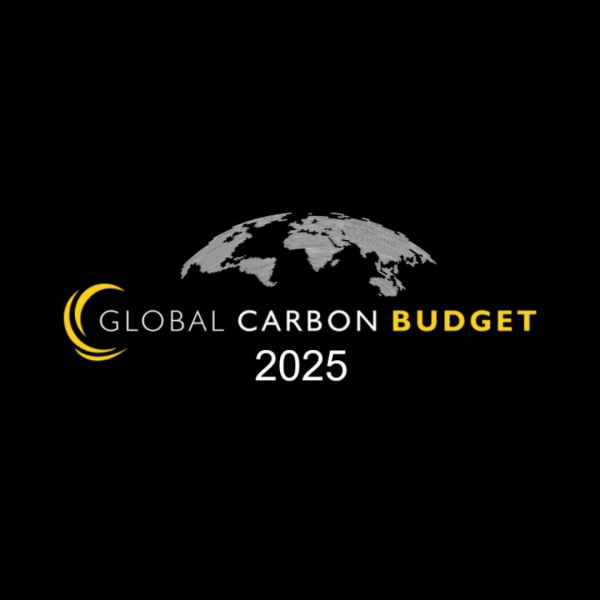Fossil Fuel CO2 Emissions Hit Record High in 2025
The report, co-authored by UMD’s Global Ecology Lab researchers George Hurtt, Louise Chini, Lei Ma and Ben Poulter, has provided annual updates on global carbon emissions and sinks since 2006.
Global carbon emissions from fossil fuels are projected to rise by 1.1% in 2025 —reaching a record high, according to new research by the Global Carbon Project.
The 2025 Global Carbon Budget projects 38.1 billion tons of fossil carbon dioxide (CO2) emissions this year. Decarbonization of energy systems is progressing in many countries, but this is not enough to offset the growth in global energy demand.
With projected emissions from land-use change (such as deforestation) down to 4.1 billion tons in 2025, total CO2 emissions are projected to be slightly lower than last year.
With the end of the 2023-24 El Niño weather pattern, which causes heat and drought in many regions, the land “sink” (absorption of CO2 by natural ecosystems) recovered this year to the pre-El Niño level.
This year’s report, published alongside a new paper in the journal Nature, examines the impact of climate change on the land and ocean carbon sinks. It finds that 8% of the rise in atmospheric CO2 concentration since 1960 is due to climate change weakening the land and ocean sinks.
The report says the remaining carbon budget to limit global warming to 1.5°C is “virtually exhausted.” With no sign of the urgently needed decline of global emissions, the level of CO2 in the atmosphere —and the dangerous impacts of global warming— continue to increase.
The research team included the Global Ecology Lab at the University of Maryland, the University of Exeter, the University of East Anglia (UEA), CICERO Center for International Climate Research, Ludwig-Maximilian-University Munich (LMU), Alfred-Wegener-Institut and more than 90 other institutions around the world.
“The UMD-GEL lab has contributed significantly to this important global report for years, by providing both global land-use forcing data and terrestrial carbon cycle modeling,” said Professor George Hurtt of the UMD-Global Ecology Lab. “This year marks the 11th year the Land Use Harmonization data was used in the report, and the third year the global Ecosystem Demography was officially included.”
Access the Full Report
Other key findings from the 2025 Global Carbon Budget include:
- China’s emissions in 2025 are projected to increase by 0.4% – growing more slowly than in recent years, due to a moderate growth in energy consumption combined with an extraordinary growth in renewable energy.
- India’s emissions are projected to increase by 1.4% – also slower than recent trends.
- An early monsoon reduced cooling requirements in the hottest months. Combined with strong growth in renewables, this led to very low growth in coal consumption.
- Emissions are projected to grow in the USA (+1.9%) and the European Union (0.4%) in 2025. Emissions in these regions have declined in recent years, but colder weather and other factors led to an increase in 2025.
- Projected emissions in Japan, provided this year for the first time, are down 2.2% in line with recent trends.
- Emissions for the rest of the world are projected to increase by 1.1%.
- The projected rise in fossil CO2 emissions in 2025 is driven by all fuel types: coal +0.8%,
oil +1%, natural gas +1.3%. - Emissions are projected to increase by 6.8% for international aviation (exceeding pre-COVID levels) but to remain flat for international shipping.
- Over the 2015-2024 period, emissions from permanent deforestation remain high at around 4 billion tons of CO2 per year, while permanent removals through re/afforestation and forest regrowth offsets about half of the permanent deforestation emissions.
- Total CO2 emissions – the sum of fossil and land-use change emissions – have grown more slowly in the past decade (0.3% per year), compared to the previous decade (1.9% per year).
- The remaining carbon budget to limit global warming to 1.5°C is virtually exhausted. The remaining budget for 1.5°C is 170 billion tons of CO2, equivalent to four years at the 2025 emissions levels.
- The combined effects of climate change and deforestation have turned Southeast Asian and large parts of South American tropical forests from CO2 sinks to sources.
- The concentration of CO2 in the atmosphere is set to reach 425.7 ppm in 2025, 52% above pre-industrial levels.
Main image: Global Carbon Budget 2025 logo
Published on Thu, 11/13/2025 - 13:37


